Nomogram based on albumin-bilirubin grade to predict outcome of the patients with hepatitis C virus-related hepatocellular carcinoma after microwave ablation
Chao An, Xin Li, Xiaoling Yu, Zhigang Cheng, Zhiyu Han, Fangyi Liu, Jie Yu, Ping Liang
Department of Interventional Ultrasound, State Key Laboratory of Kidney Disease, The Chinese PLA General Hospital, Beijing 100853, China
ABSTRACT Objective:To construct a nomogram based on the albumin-bilirubin (ALBI) grade to provide prognostic value for hepatitis C virus (HCV)-related hepatocellular carcinoma (HCC) patients who underwent ultrasound-guided percutaneous microwave ablation (US-PMWA).Methods:From April 2005 to January 2018, 183 treatment-na?ve patients with 251 HCV-related HCCs according to the Milan criteria received US-PMWA subsequently. The overall survival (OS) and recurrence-free survival (RFS) were compared between groups classified by ALBI grade. Cox proportional hazard regression model based on risk factors for survival and recurrence was used to construct the nomogram.Results:The cumulative OS rates at 1-, 3-, 5- and 10-year were 97.7%, 73.6%, 54.5% and 34.5%, respectively. Stratified according to ALBI grade, the 1-, 3-, and 5-year OS in the ALBI grade 1 group and grade 2 group were 99.2%, 92.4%, 77.9% and 97.7%,52.3%, 38.6%, respectively, with significant statistical difference (P < 0.001). No significant statistical difference was detected in the 1-, 3-, and 5-year RFS rates in the ALBI grade 1 group and grade 2 group (P = 0.220). The major complication rate was 1.6%.Multivariate analysis results showed age, α-fetoprotein level, tumor number, platelet count, location, Child-Turcotte-Pugh (CTP)and ALBI grade were associated with OS, which generated the nomograms. Internal validation with 1000 bootstrapped sample sets had good concordance index of 0.769 (95%CI 0.699-0.839) in OS.Conclusions:This nomogram based on ALBI grade was a visualization risk model, which could provide personalized prediction of long-term outcomes for HCV-related HCC patients after US-PMWA.
KEYWORDS Nomogram; albumin-bilirubin grade; hepatitis C virus; hepatocellular carcinoma; microwave ablation
Introduction
Hepatocellular carcinoma (HCC) is a common complication related to hepatitis C virus (HCV) infection with considerable mortality and morbidity rates1,2. The incidence of HCV-related HCC, which is lower than that of HCC caused by hepatitis B virus (HBV) in China, however, has increased in a stepwise manner during the past twenty years3,4. Although antiviral therapy, including direct-acting antiviral (DAA) agents and interferon therapy (IFN), has been used as an effective treatment for HCV infection,recurrence of HCC after curative treatment is still critical for long-term outcomes5-7.
Currently, the treatments for early-stage HCC patients recommended in the guidelines mainly include surgical resection, liver transplantation and local ablation therapy8.Nevertheless, many patients have lost the curative opportunity due to poor physical condition and shortage of organ donors. As a slim chance of survival for the patients with HCC, ultrasound-guided microwave ablation (MWA) is superior to radiofrequency ablation (RFA) because of its advantages, including higher intratumoural temperature,shorter operation time and less dependence on the electrical conductivities. As one of the most recent techniques in the field of thermoablation, MWA has been confirmed as a safe and effective treatment for HCC patients with stage 0/A based on the Barcelona Clinic Liver Cancer (BCLC) staging system9-11. With the recent advances in several interventional assistance technologies (e.g., internally cooled microwave generator, artificial ascites or pleural effusion, threedimensional (3D) visualization preoperative planning and contrast-enhanced ultrasound (CEUS) guidance), the accuracy and effectiveness of treatment for the tumour on the surrounding location have been improved12-15. Most studies have reported oncologic outcomes of MWA for patients with HCC and analysed risk factors related to survival and recurrence16,17. However, studies on patients with HCVrelated HCC who underwent US-PMWA remain scarce. A nomogram is a visual risk regression model and an ideal tool for predicting HCC patients’ prognosis, which is derived from various hazard functions18,19. Moreover, nomograms have been applied to predict outcomes of HCC patients after liver resection, transarterial chemoembolization (TACE) and RFA, while those of HCC patients who underwent MWA have never been reported20-22.
Hepatic functional reserve has always been considered to be critical for outcomes of HCC patients due to cirrhosis progression. Child-Pugh grade is the most widely used assessment method for hepatic functional reserve, but highly subjective factors, such as severity of ascites and degree of hepatic encephalopathy, may affect assessment ability23.Recently, as a simple and objective evaluation method,albumin—bilirubin (ALBI) grade has been applied to assess hepatic functional reserve24-26, and a nomogram based on ALBI grade has been used to predict outcomes of patients with HCC after RFA27. Learning from the previous studies,we designed a plan, and the main aim was to construct a nomogram with the ALBI grade to assess the long-term outcomes of patients with HCV-related HCC after USPMWA. In this way, the tumour recurrence and survival prognosis of patients with HCV-related HCC was further analysed and discussed.
Materials and methods
Patients and clinicopathologic data
This study was conducted in accordance with the principles of the Declaration of Helsinki, and the study protocol was approved by the ethics committee of Chinese PLA General Hospital. Because of the retrospective nature of the study,patient consent for inclusion was waived. The medical records of all HCV-related HCC patients between April 2005 and January 2018 were reviewed. For this cohort study, the primary diagnosis of patients with HCV-related HCC was based on HCV-infected individuals with cirrhosis and abdominal ultrasound combined with serum alphafetoprotein (AFP) level. The final diagnosis was based on pathologic findings of needle biopsy samples before ablation.The inclusion criteria were as follows: (a) a single tumour with a maximum size smaller than 5 cm and tumour number less than 3 according to the Milan criteria, (b) no major vascular invasion or extrahepatic metastasis, (c) HCVinfected patients, and (d) absence of ascites. The exclusion criteria were as follows: (a) recurrent HCC; (b) serious medical comorbidities, including heart, lung and renal dysfunction; (c) severe coagulation disorders (i.e.,prothrombin time > 25 s, prothrombin activity < 40%, and platelet count < 50 cells × 109/L); or (d) active severe infection.
During the study period, 2632 consecutive patients with HCC underwent percutaneous MWA. Among them, 183 patients with 251 tumours (mean age, 64.6 years ± 9.1; range,32—84 years) met the inclusion criteria and were included in this study. ALBI score was calculated before treatment using the appropriate clinical parameters, and ALBI grade was defined as follows: (log bilirubin [μmol/L] × 0.66) +(albumin [g/L] × -0.085); grade 1 ≤ -0.260, -2.60 < grade 2< -1.39 and grade 3 ≥ -1.39. Stratified according to ALBI grade, clinicopathologic data, including age, gender, tumour characteristics, comorbid disease, pathological differentiation, Barcelona Clinic Liver Cancer (BCLC) grade,Child-Turcotte-Pugh (CTP) grade, α-fetoprotein, albumin,total bilirubin, alanine aminotransferase (ALT), aspartate aminotransferase (AST), γ-glutamyl transferase (GGT),prothrombin time, international normalized ratio (INR),platelet count and creatinine were collected.
The MWA device, procedure and interventional assisted techniques were described in previous reports28-30. All ablative procedures were performed percutaneously by three interventional radiologists, namely, P.L., X.L.Y., and Z.G.C., who had 25, 25, and 15 years of experience with MWA, respectively. US-PMWA was performed successfully until all of the tumours were ablated completely. The treatment parameters, including antenna number, insertion number, ablation time, ablation power, treatment session,and interventional assistive techniques, including hydrodissection technique, contrast-enhanced ultrasound(CEUS) guidance and 3D visualization preoperative planning, were collected.
Follow-up and endpoints
Contrast-enhanced images were obtained at 1 and 3 months after ablation and every 3 months thereafter until January 2018. Thereafter, the follow-up visit covered several evaluations, including routine physical examination,laboratory tests, such as total bilirubin, serum albumin,prothrombin time and tumour marker levels, and contrastenhanced imaging, including US, CT or MRI. Technique effectiveness was defined as the absence of contrastenhancement on imaging in any area of the mass after one month.
The endpoints of this study were death and tumour recurrence. In this study, local tumour recurrence,intrahepatic distant recurrence and metastasis all were regarded as tumour recurrence. Local tumour recurrence was defined based on imaging findings of an irregular nodular,scattered, or eccentric pattern of peripheral enhancement around the ablation zone in the patients after US-PMWA.Intrahepatic distant recurrence was defined as the appearance of an irregular, scattered, or eccentric pattern of a peripheral enhancement intrahepatic lesion, which was farther away from the ablation zone after MWA. Once tumour recurrence was found, a second MWA treatment was arranged. Overall survival (OS) was calculated from the date of the first session of MWA treatment to the date of death or last date of followup (survival or loss). Recurrence-free survival (RFS) was calculated from the date of the first session of MWA treatment to the date of tumour recurrence or the last date of follow-up (no finding of recurrence or loss). Major complications were defined as events which caused substantial morbidity and disability that increased the level of care, led to hospital admission, or substantially prolonged the hospital stay31.
Statistical analysis
Statistical analyses were performed using SPSS 19.0 (SPSS,Chicago, IL). Either Pearson χ2analysis or Fisher exact tests were performed to compare the categorical variables, and Student’s t -test was applied to compare the continuous variables. The overall survival (OS) and recurrence-free survival (RFS) rates were assessed by the Kaplan—Meier method with the log-rank test. A Cox proportional hazards model was used to identify the significant effects of risk factors on the survival and recurrence rate. For all tests, a P value of less than 0.05 was considered to be statistically significant. Univariate and multivariable analyses of independent prognostic factors were evaluated by means of the forward stepwise Cox regression model. The β coefficients originating from the Cox model were used to construct the nomogram to assess the association of variables with OS and RFS after MWA. Internal validation with 1000 sets of bootstrap samples was performed to evaluate the use of the nomogram for assessment of OS and RFS of patients who undergo MWA. In addition, the performance of the model was evaluated by discrimination and calibration via Harrell's concordance index (C-index) and plotting the Kaplan-Meier curves of the tertile of predictions and the calibration curves using the model. Homogeneity was compared in different statistical models for different stages of HCC, which was generated by means of the parametric survival analysis. The Akaike information criterion, which discloses an overall assessment of different statistical models for serum markers of HCC, was performed with the Cox proportional hazards model. Construction of the nomogram was performed by using R software version 3.0.2.
Results
Baseline characteristics
According to the abovementioned formula, 183 patients with HCV-related HCC were divided into two subgroups according to ALBI grade. In this study, there were 95 patients(28 females, 67 males; average age 63.9 ± 9.0 years) in the ALBI grade 1 group and 88 patients (21 females, 67 males;average age 65.4 ± 9.2 years) in the ALBI grade 2 group. In the ALBI grade 1 group, 147 patients had a single tumour; 36 patients had multiple tumours; and the median maximum tumour diameter was 2.7 cm (range, 0.7-5.0 cm). In the ALBI grade 2 group, 80 patients had a single tumour; 15 patients had multiple tumours; and the median maximum tumour diameter was 2.8 cm (range, 0.8-5.0 cm). The characteristics of the patients and tumours are summarized in Table 1. The MWArelated treatment parameters are summarized in Table 2.
Midterm oncologic outcome and recurrence
The median follow-up period of patients was 29.9 months(range 3.3-122.2 months). Among 183 patients who underwent US-PMWA, 57 (31.1%) died and 107 (58.5%)experienced recurrence during the observation period. The cumulative OS rates at 1, 3, 5 and 10 years were 97.7%,73.6%, 54.5% and 34.5%, respectively. The cumulative RFS rates at 1, 3, and 5 years were 61.1%, 37.3% and 6.9%,respectively. The 1-, 3-, and 5-year OS rates in the ALBI grade 1 group and ALBI grade 2 group were 99.2%, 92.4%,and 77.9% and 97.7%, 52.3%, and 38.6%, respectively(Figure 1A), showing a statistically significant difference (P<0.001). The 1-, 3-, and 5-year RFS rates in the ALBI grade 1group and ALBI grade 2 group were 62.4%, 46.6%, and 12.2% and, 59.6%, 34.5%, and 0%, respectively (Figure 1B),showing no statistically significant difference (P = 0.220).Major complications related to the MWA procedure were observed in three patients (1.6%), including one with a liver abscess found in the ALBI grade 1 group and one with a pleural effusion and one with seeding found in the ALBI grade 2 group, showing no statistically significant difference(P= 0.609).
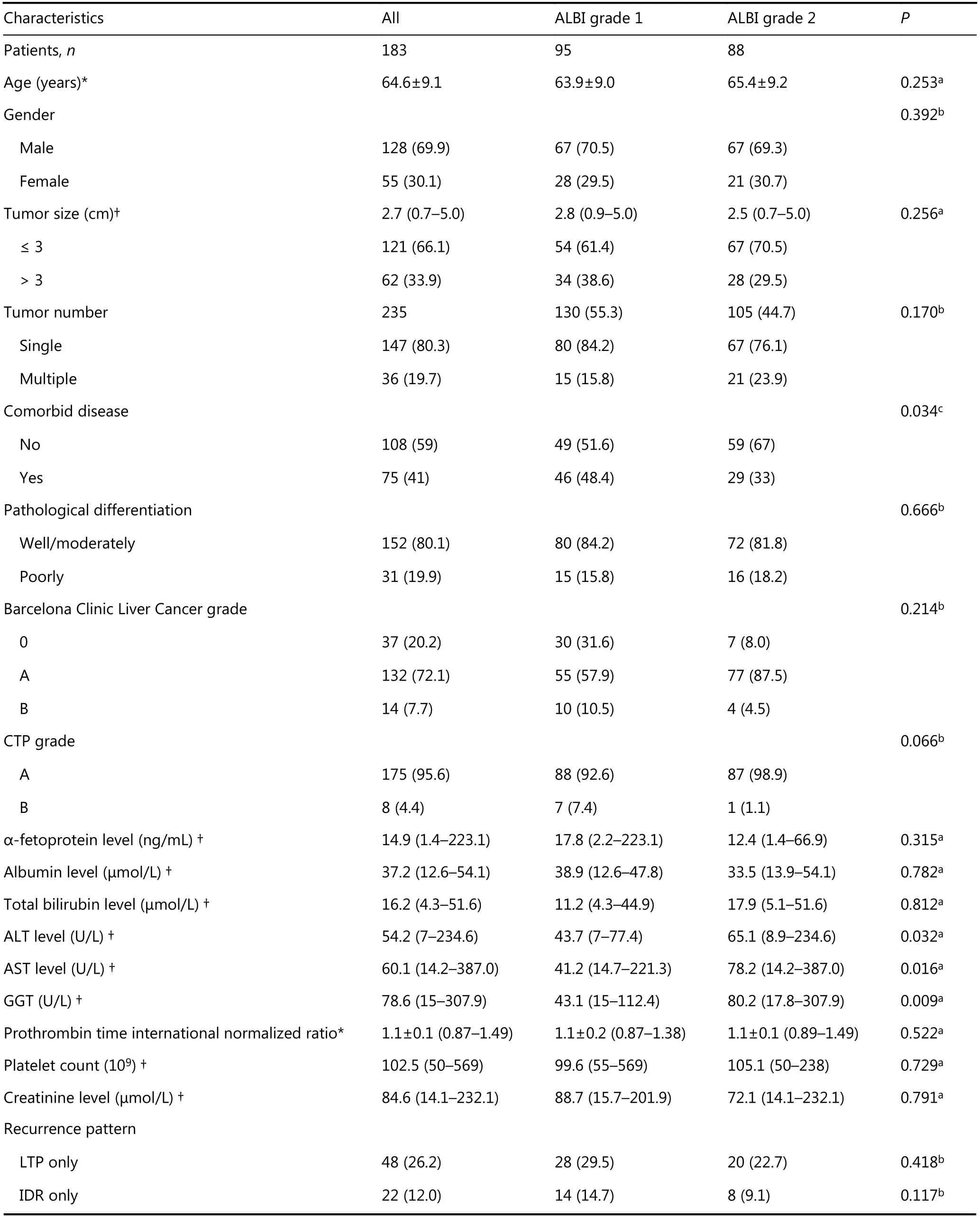
Table 1 Baseline characteristics of patients undergoing MWA

Continued
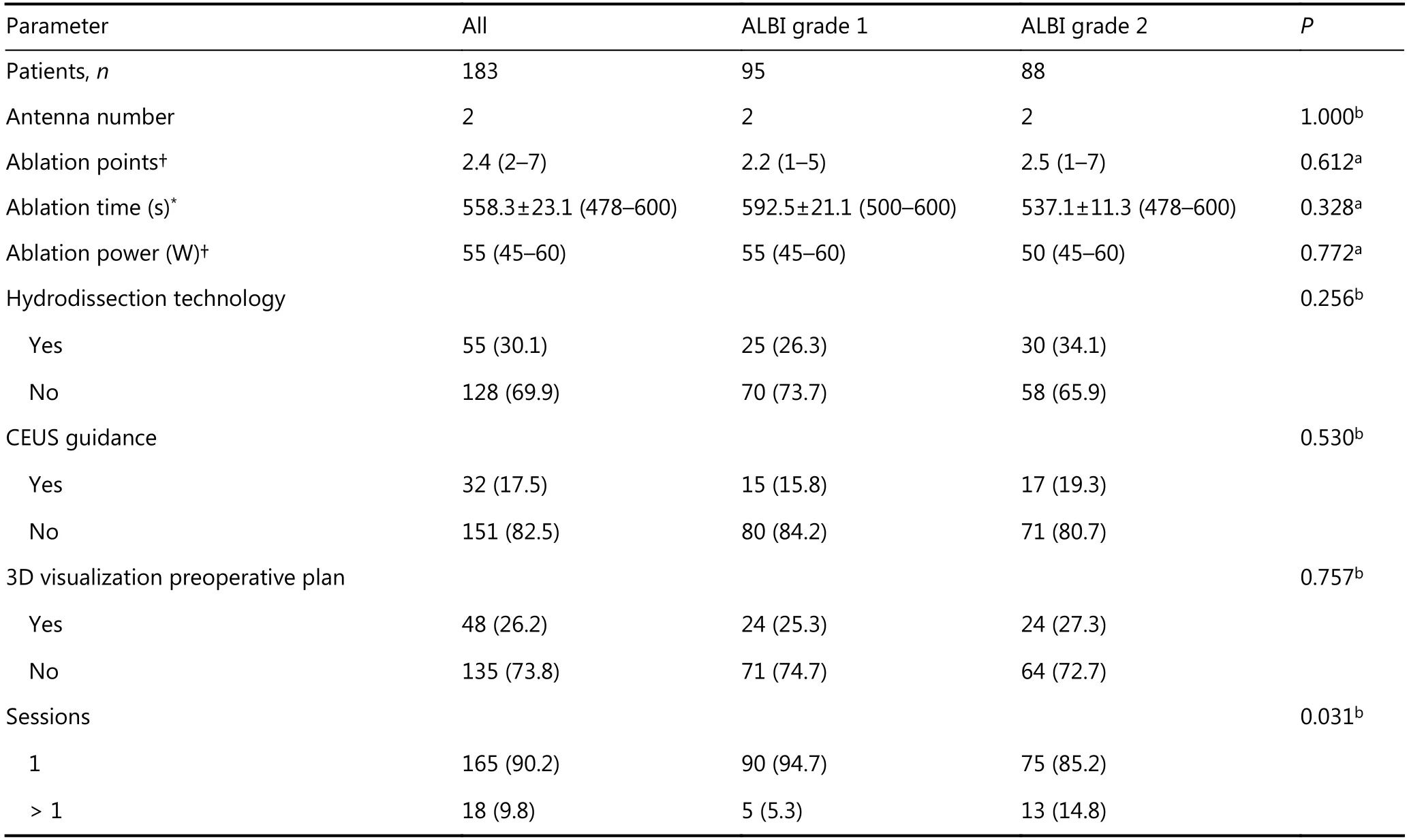
Table 2 The parameters related with ultrasound-guided MWA
Univariate and multivariate analyses

Figure 1 The 1-, 3-, and 5-year OS rates in the ALBI grade 1 group and ALBI grade 2 group were 99.2%, 92.4%, and 77.9%; 97.7%, 52.3%,and 38.6%, respectively, showing significant statistical difference (P < 0.001) (A). The 1-, 3-, and 5-year RFS rates in the ALBI grade 1 group and ALBI grade 2 group were 62.4 %, 46.6%, and 12.2%; 59.6%, 34.5%, and difference (P = 0.220) (B).
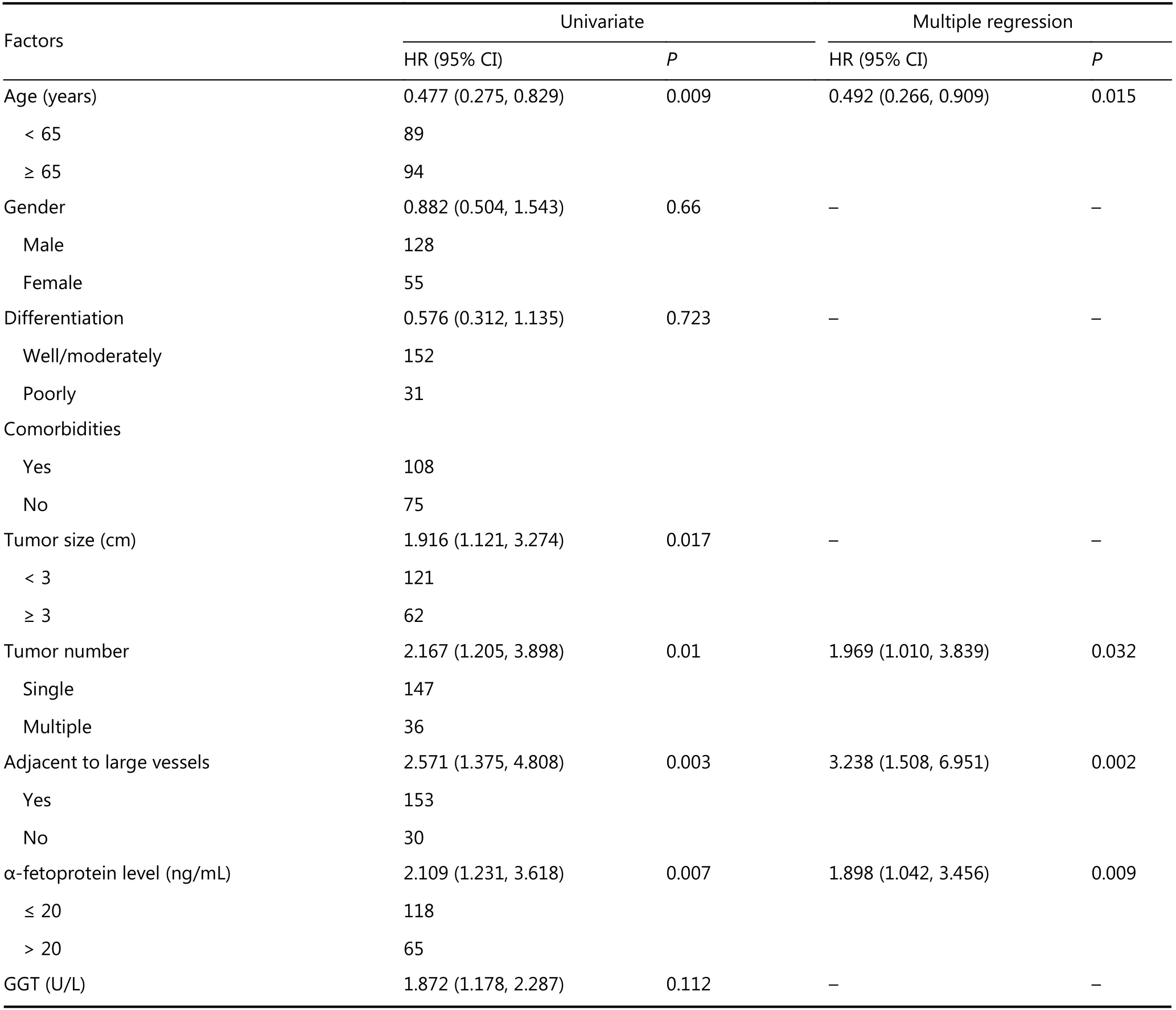
Table 3 Factors associated with overall survival
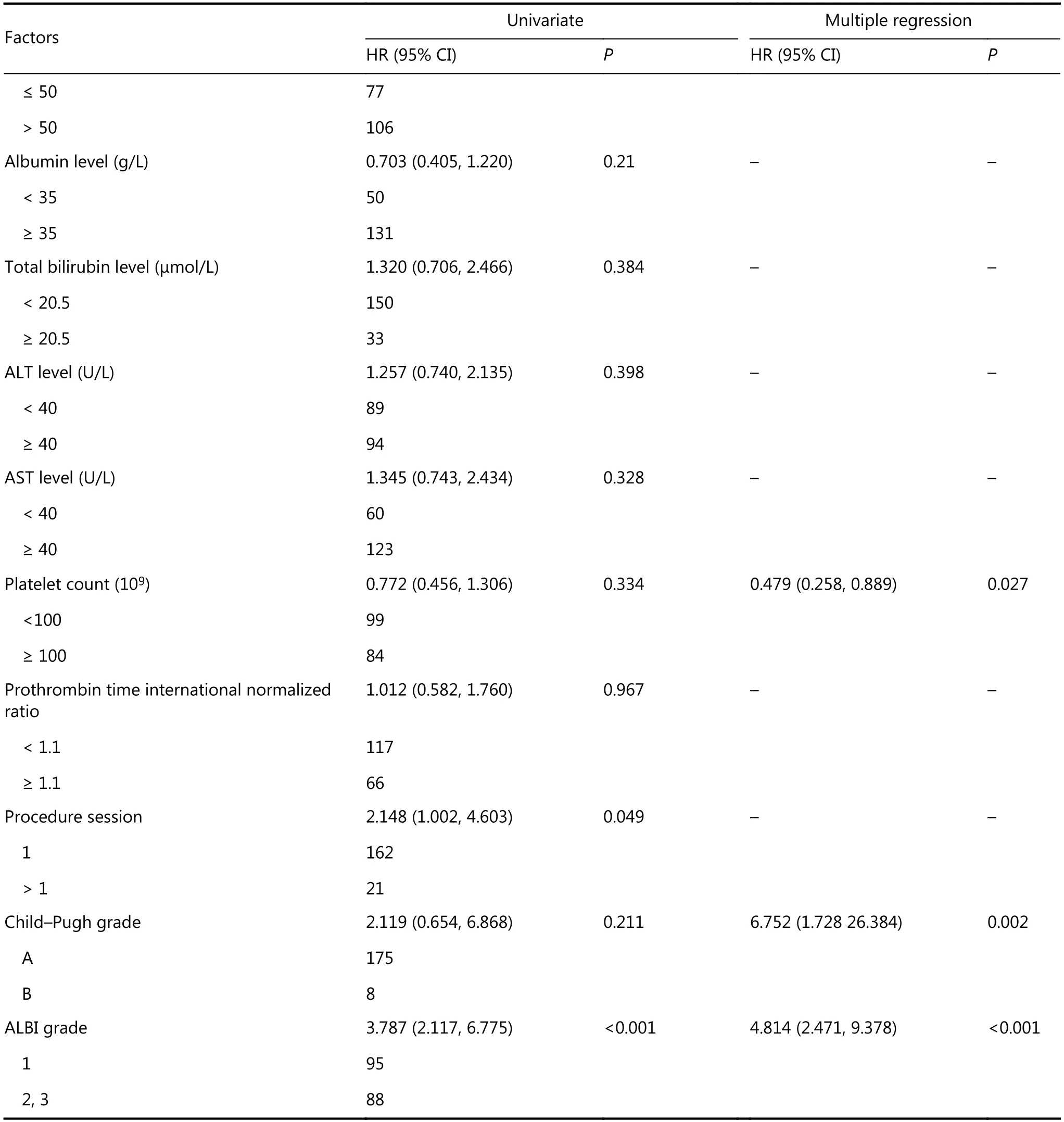
Continued
Univariate and multivariate logistic regression analyses were performed to identify predictors influencing the long-term outcome of patients with HCV-related HCC who underwent US-PMWA. The univariate analysis showed statistically significant differences in terms of the OS rate depending on the age (HR = 0.477; P = 0.009), tumour size (HR = 1.916;P = 0.017), tumour number (HR = 2.167; P=0.010), adjacent large vessels (HR = 2.571; P = 0.003), α-fetoprotein level(HR = 2.109; P = 0.007), procedure session (HR = 2.148; P =0.049) and ALBI grade (HR = 3.787; P < 0.001) (Table 3).The multivariate analysis showed that the factors that significantly affected the OS rate were age (HR = 0.492; P =0.015), tumour number (HR = 1.969; P = 0.032), adjacent large vessels (HR = 3.238; P = 0.002), α-fetoprotein level(HR = 1.898; P = 0.009), platelet count (HR = 0.479; P =0.027), CTP grade (HR = 6.579; P = 0.002) and ALBI grade(HR = 4.814; P < 0.001) (Table 3). The univariate analysis showed statistically significant differences in terms of RFS rates depending on the age (HR=0.632; P=0.022), gender(HR = 1.512; P = 0.046), adjacent large vessels (HR = 0.154;P = 0.046), α-fetoprotein level (HR = 1.884, P = 0.002), DAA therapy (HR = 1.413; P = 0.003) and procedure session(HR = 1.877; P = 0.046) (Table 4). The multivariate analysis showed that the factors that significantly affected the RFS rate were age (HR = 0.548; P = 0.003), α-fetoprotein level (HR =1.760; P = 0.002) and DAA therapy (HR = 0.392; P = 0.023)(Table 4).
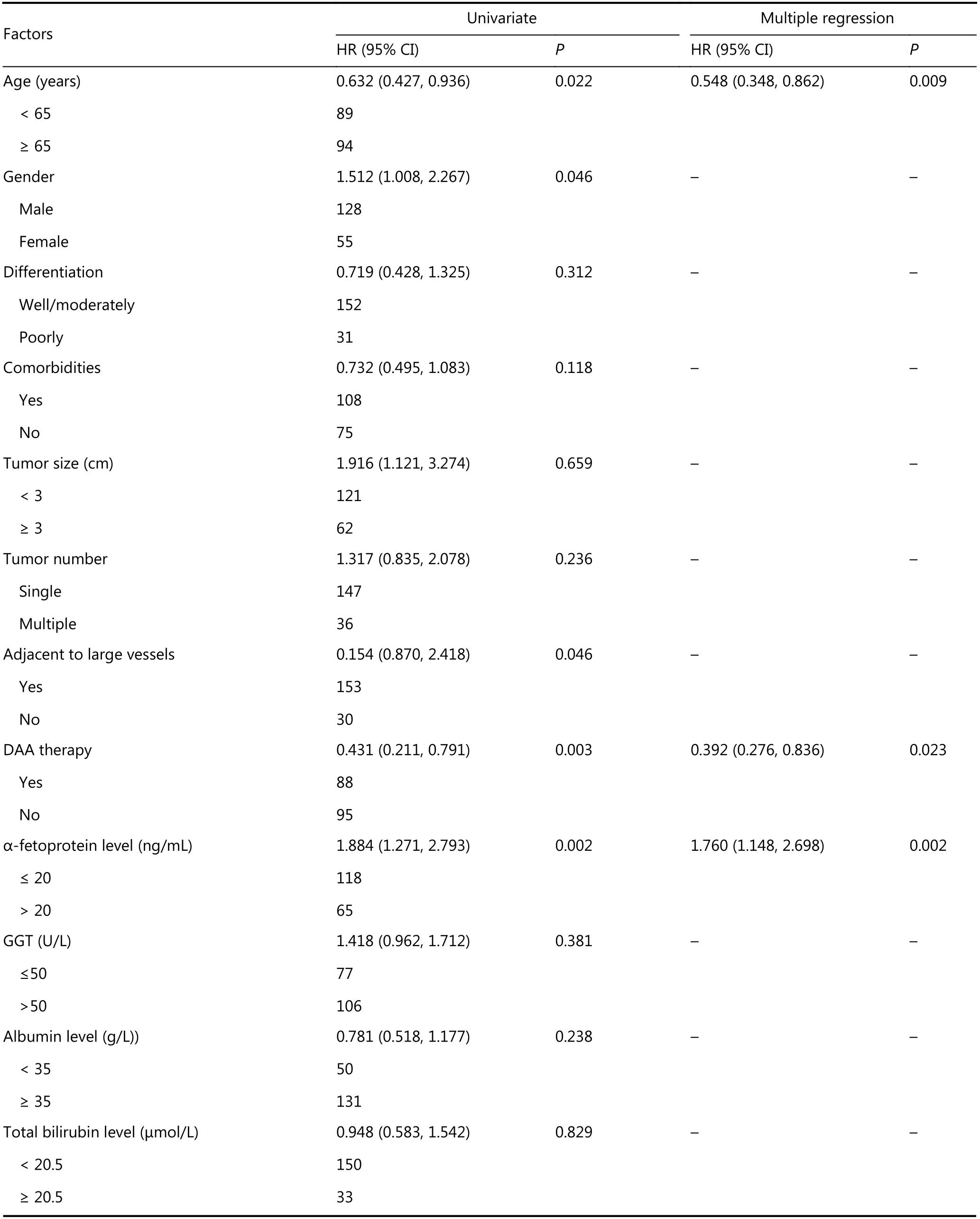
Table 4 Factors associated with recurrence-free survival
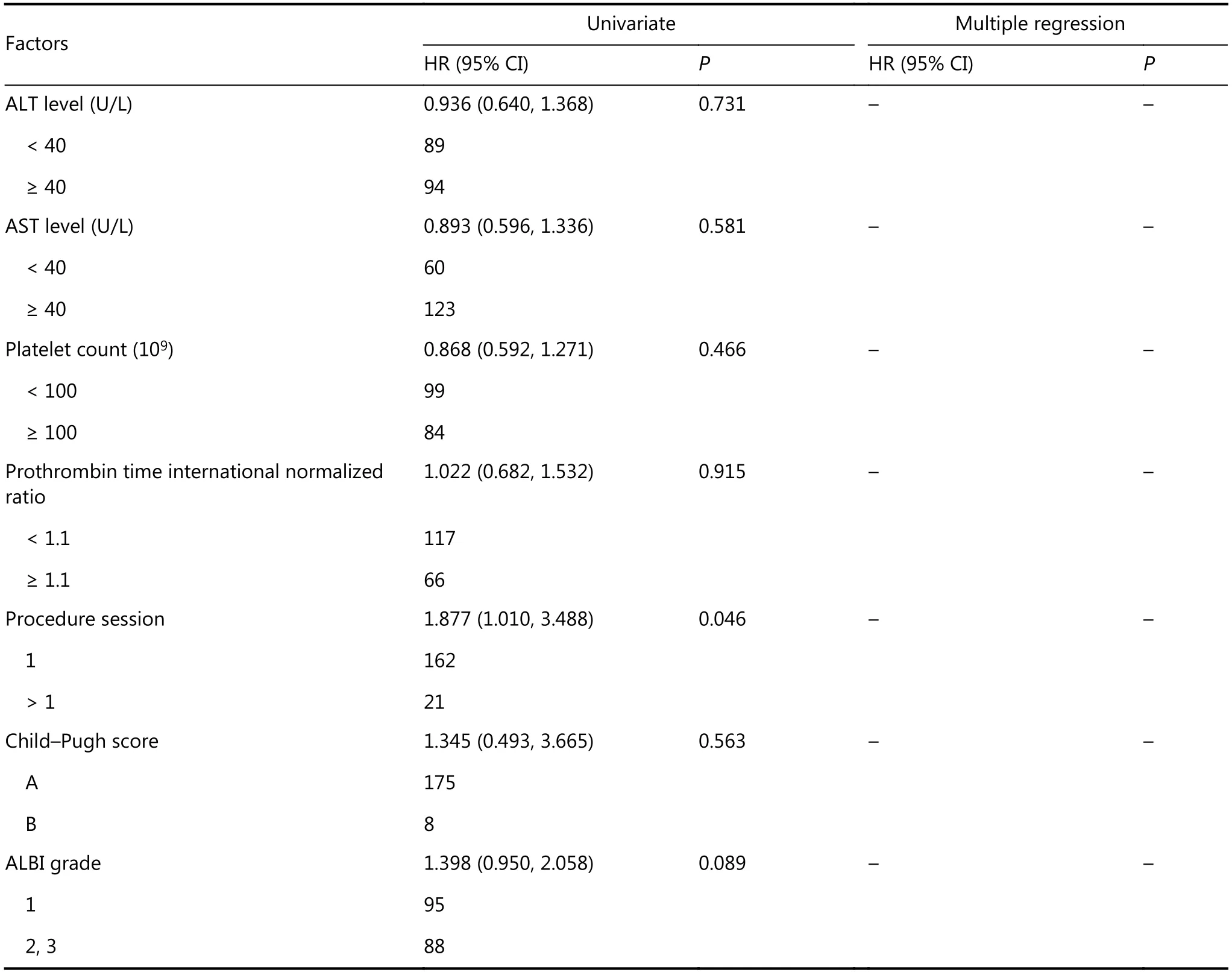
Continued
Construction and validation of the nomogram
The nomogram was constructed by using β-coefficients to determine the proportional prognostic effect of the seven independent risk factors to assess their association with OS in the multivariate analysis. Each enrolled patient received one individualized grade, which was the sum of the points from these seven prognostic variables. The projections from the total points (range, 0-260) shown on the scales in Figure 2 indicated the estimated probability of OS at 1, 3 and 5 years.The concordance index for the model for assessment of RFS after MWA was 0.769 and with 1000 cycles of bootstrapping(95% CI: 0.699-0.839). The projections from the total points(range, 0-300) shown on the scales in Figure 3 indicated the estimated probability of RFS at 1 and 3 years. The concordance index for the model for assessment of OS after MWA was 0.637 and with 1000 cycles of bootstrapping (95%CI: 0.582-0.692). Calibration curves plotted with a 1-, 3- and 5-year overall survival were ideal-matched with the idealized 45° line (Figure 4), and calibration curves plotted with a 1-and 3-year RFS were ideal-matched with the idealized 45°line (Figure 5).
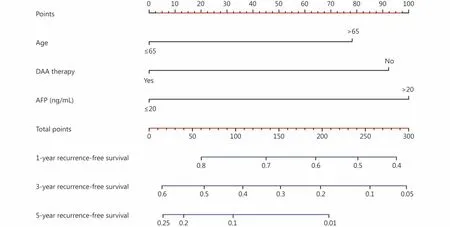
Figure 3 Nomogram shows the assessment of 1-, 3- and 5-year RFS of patients with HCV-related HCC who underwent MWA.
Comparison of markers for associations with OS after MWA
The prognostic performance of ALBI grade, CTP grade,BCLC grade, Model for End-Stage Liver Disease (MELD)grade, α-fetoprotein level, INR, platelet count, AST level and ALT level were evaluated with homogeneity and Akaike information criterion methods. Table 5 shows that ALBI had the highest homogeneity and lowest Akaike information criterion value compared with the other criteria.
Discussion
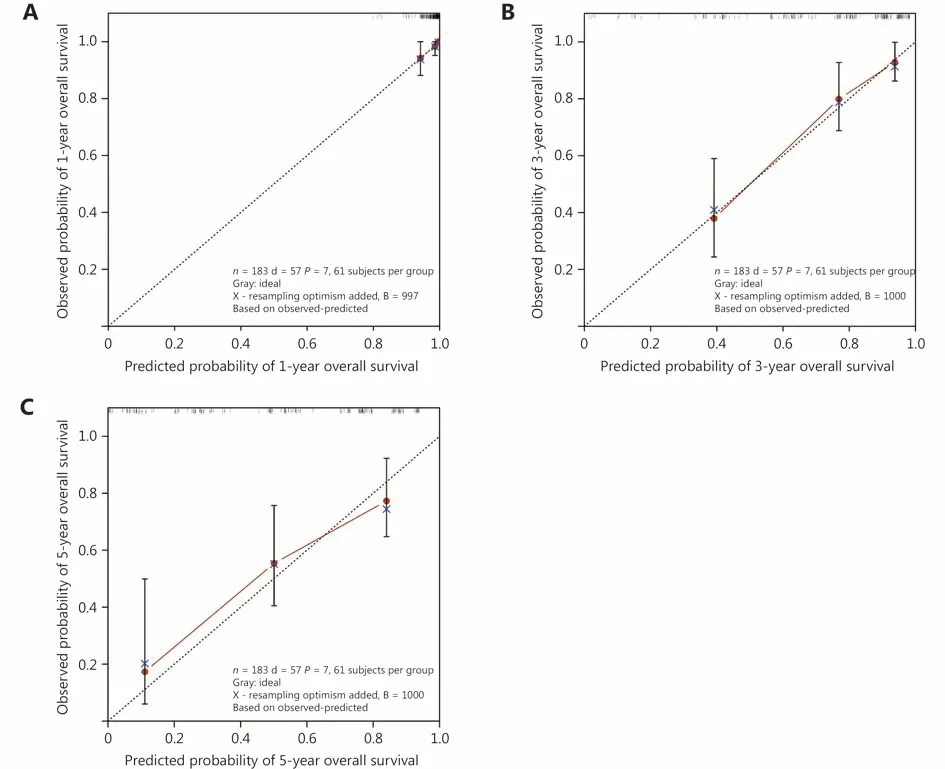
Figure 4 Calibration plot of the nomogram. Calibration curves of the nomogram at 1-year (A), 3-year (B) and 5-year (C) shows good correlation between assessed and observed OS. Calibration curves were close to 45° line.
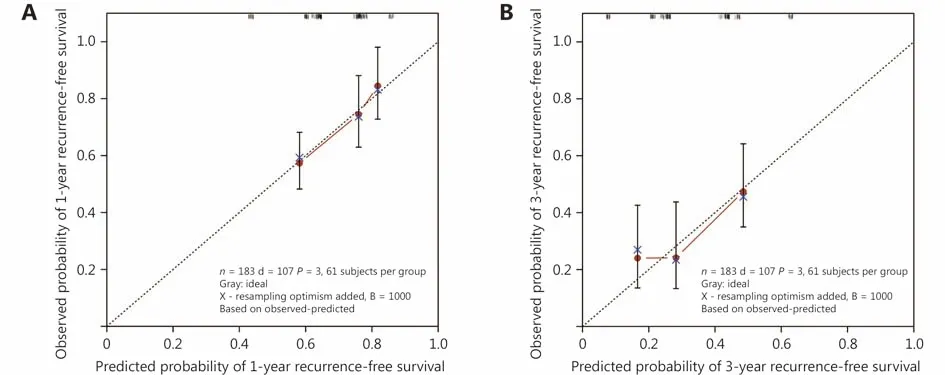
Figure 5 Calibration plot of the nomogram. Calibration curves of the nomogram at 1-year (A) and 3-year (B) shows good correlation between assessed and observed RFS. Calibration curves were close to 45° line.

Table 5 Assessment accuracy of biomarkers and clinical grade for overall survival after MWA
As a mature thermal ablation technology, MWA has been widely used in the treatment for liver malignancy in China.Previous studies have reported much data on MWA in HCC,but detailed analysis related to the patients with HCV-related HCC has not yet appeared. There were several innovation points in this study. First, patients with HCV-related HCC who underwent MWA were reported initially in the study,while many studies on HBV-related HCC after MWA were previously reported. The long-term outcome of 10-year survival was observed. Second, ALBI grade instead of CTP grade had been the most important criterion for evaluating liver function, which was associated with many advantages,such as being simple, objective and evidence-based. In this study, ALBI grade exhibited excellent discriminative ability for assessment of OS and RFS of patients with HCV-related HCC after MWA but was not applicable to assessment of tumour recurrence. Third, we applied nomograms as prognostic devices in the death of patients with HCV-related HCC, from which a statistical prognostic model can be determined that generates a probability of a clinical event for a particular individual.
Yu et al.32reported the largest series involving the use of MWA for HCC in a single institution and found that the 1-,3- and 5-year cumulative survival rates were 93%, 72% and 51%, respectively. Patients with a single tumour, tumour size< 4 cm and Child A cirrhosis had a higher probability of long-term survival. There is a difference in prognosis between HBV-related HCC in previous studies and HCVrelated HCC in this study. However, when we considered the differences in patient number, abutting major vessel or organ, liver functional reserve and preoperative treatment, it was not appropriate to compare our study results directly with those of previous studies. In addition, because the CTP grade has a certain subjectivity, we used ALBI grade as an alternative method for assessment of hepatic functional reserve. Many studies have demonstrated the important role of liver function in the prognosis of HCC. Therefore, we divided the patients into two subgroups according to ALBI grade and compared OS and RFS between the two groups.The results demonstrated that the OS of the ALBI grade 1 group was higher than that of the ALBI grade 2 group,whereby the RFS of the patients had no statistically significant difference. This result suggests that hepatic functional reserve was critical for outcomes of patients with HCC. To further verify the reliability of ALBI grade, among the biomarkers related to OS after MWA, ALBI grade has estimated capability over other criteria according to discriminatory ability, homogeneity and Akaike information criterion, which was an important reference for the treatment of patients and assessment of their outcomes.
In this study, we identified the independent risk factors for OS and recurrence of patients with HCV-related HCC who underwent MWA. Older age, poor hepatic functional reserve(i.e., ALBI grade and CTP grade) and tumour factors (i.e.,tumour size, tumour number and a-fetoprotein levels), more treatment sessions and adjacent large vessels were associated with poorer OS, and without DAA therapy, high afetoprotein levels and older age were associated with a higher recurrence rate after MWA, which was consistent with the results of previous studies33. Among the risk factors, patients older than 65 years with high α-fetoprotein levels need to prompt the vigilance of the physician. Based on these risk factors, we constructed a nomogram related to individualized risk estimations for OS of patients who underwent MWA for HCV-related HCC. This nomogram demonstrated a high discriminatory ability with an ideal concordance index of 0.769. Moreover, three calibration curves were used to retest and showed an ideal level of accuracy and better net benefit for the prediction of 1-, 3- and 5-year OS. In addition,another nomogram demonstrated a lower discriminatory ability with a concordance index of 0.637 in RFS. Depending on the nomogram derived from preoperative clinical variables to assess prognosis for individual patients with HCV-related HCC after MWA, interventional radiologists can easily explain the risk of the operation to the patient's family and set up a detailed treatment schema.
There were several limitations in our study. First, this is a single-center retrospective study with a relatively small sample. Limited sample size might have reduced statistical power in comparative analysis so that some associations were not detected. Second, all of the patients in our cohort were treated at one medical center, therefore referral bias could not be completely avoided. Multi-center prospective study of the application is needed to validate the prognostic accuracy.Final, robust nomogram should be validated externally in different patient cohorts such as patients with HBV-related HCC.
Conclusions
In conclusion, the long-term outcomes of HCV-related HCC patients after MWA were encouraging. The nomogram with ALBI grade may provide prognostic value in 1-, 3- and 5-year RFS and OS for individual patients and was effective in assisting the physician with designing the treatment strategy.
Acknowledgments
This work was supported by the National Key R&D Program of China (Grant No. 2017YFC0112000); the National Natural Science Foundation of China (Grants No. 81627803,91859201, and 81871374); the State Key Project on Infectious Disease of China (Grant No. 2018ZX10723204).
Conflict of interest statement
No potential conflicts of interest are disclosed.
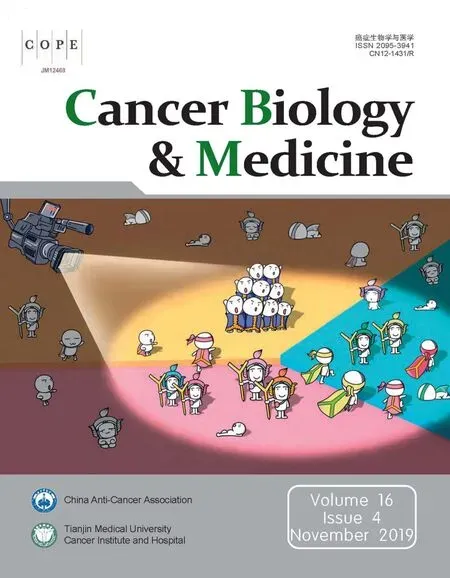 Cancer Biology & Medicine2019年4期
Cancer Biology & Medicine2019年4期
- Cancer Biology & Medicine的其它文章
- Interpretation of breast cancer screening guideline for Chinese women
- Breast cancer screening guideline for Chinese women
- Erratum to Simultaneous inhibition of PI3Kα and CDK4/6 synergistically suppresses KRAS-mutated non-small cell lung cancer
- The correlation and overlaps between PD-L1 expression and classical genomic aberrations in Chinese lung adenocarcinoma patients: a single center case series
- Omics-based integrated analysis identified ATRX as a biomarker associated with glioma diagnosis and prognosis
- ILF2 cooperates with E2F1 to maintain mitochondrial homeostasis and promote small cell lung cancer progression
